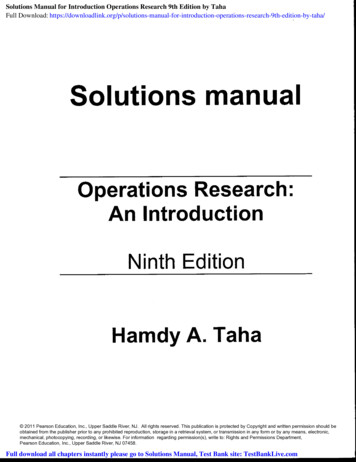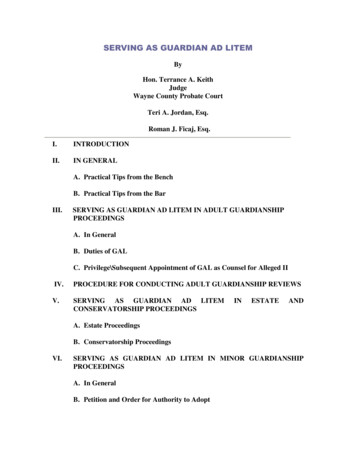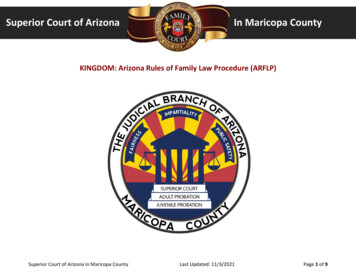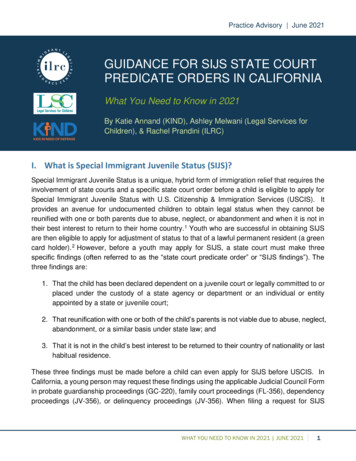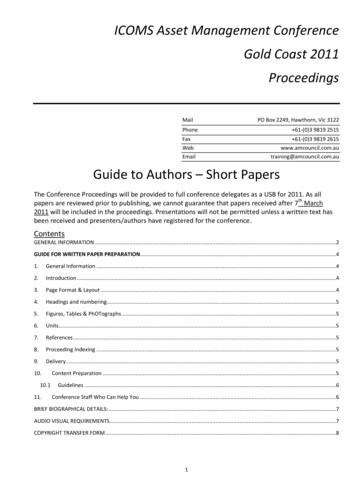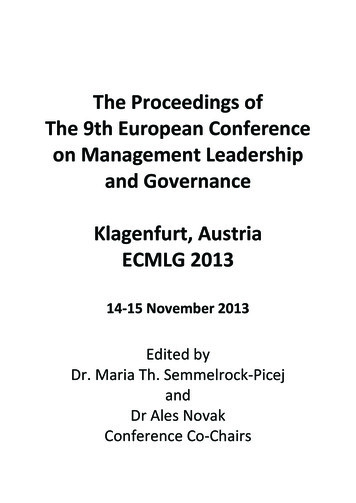
Transcription
The Proceedings ofThe 9th European Conferenceon Management Leadershipand GovernanceKlagenfurt, AustriaECMLG 201314-15 November 2013Edited byDr. Maria Th. Semmelrock-PicejandDr Ales NovakConference Co-Chairs
Copyright The Authors, 2013. All Rights Reserved.No reproduction, copy or transmission may be made without written permission from the individual authors.Papers have been double-blind peer reviewed before final submission to the conference. Initially, paper abstracts were readand selected by the conference panel for submission as possible papers for the conference.Many thanks to the reviewers who helped ensure the quality of the full papers.These Conference Proceedings have been submitted to Thomson ISI for indexing. Please note that the process of indexingcan take up to a year to complete.Further copies of this book and previous year’s proceedings can be purchased from http://academic-bookshop.comE-Book ISBN: 978-1-909507-88-3, E-Book ISSN: 2048-903XBook version ISBN: 978-1-909507-86-9, Book Version ISSN: 2048-9021CD Version ISBN: 978-1-909507-89-0, CD Version ISSN: 2048-9048The Electronic version of the Proceedings is available to download at ISSUU.com.How to use Issuu for the first time1.2.3.4.5.6.7.Go to the ISSUU home page at www.issuu.com and from there click “log in” - if this is your first visit click “sign up now”on the log in screen.Enter your name, e-mail address and choose a password.You should then almost immediately receive an e-mail from ISSUU asking you to confirm your details. Do not closescreen until verified on e-mail.There will be a “Welcome back message to verify your account – click verify account. Clicking on the link sent in the email will take you to the ISSUU homepage.Type http://issuu.com/acpil into the search box at the top of the screen.The proceedings will be displayed they can be opened with various options printing/saving the proceedings being one ofthem. Note: click on the Share button at the bottom of the screen in order to access and download the proceedings.When you return to ISSUU.com as a subscriber you will be able to log in straight away.Published by Academic Conferences and Publishing International Limited, g
ContentsPaper sviiiPersonality and Expectations for LeadershipTiina Brandt, Piia Edinger and SusannaKultalahti1The Effect of Ownership Structure on Corporate FinancialPerformance in the Czech RepublicOndřej Částek7Value Co-Creation in the Organizations of the FutureEng Chew16The Free State Department of Education: An Audit andCorporate Governance PerspectiveCornelie Crous24The Relationship Between Governance and Performance:Literature Review Reveals new InsightsPeter Crow, James Lockhart and Kate Lewis35Creative Industries and Creative Index: Towards Measuringthe "Creative" Regional PerformanceLukáš Danko and Pavel Bednář42Human Resource Control Systems and Family FirmPerformance: The Moderating Role of GenerationJulie Dekker, Nadine Lybaert and TensieSteijvers50The Challenges and Benefits of the Multi-factor LeadershipQuestionnaire (MLQ), in Terms of Gender and the Level ofAnalysis: A Critical Review of Current ResearchAmir Elmi Keshtiban58Role of Internet in Supply Chain Integration: EmpiricalEvidence From Manufacturing SMEs Within the UKHajar Fatorachian, Malihe Shahidan andHadi Kazemi66Emerging Organisational Forms: Leadership Frames andPowerBryan Fenech76Responsible Internationalisation of Management Education:Understanding International Students’ Learning andTeaching Needs at a UK Business SchoolTatiana Gladkikh, Mark Lowman, MarijaDavis, Mike Davies, Mandy Jones, PhillJennison and Amy Tan84IT Governance, Decision-Making and IT CapabilitiesKari Hiekkanen, Janne Korhonen, ElisabetePatricio, Mika Helenius and Jari Collin92Effective Leadership – can Soft Skills Contribute to theEffectiveness of an Organization?Miloslava Hirsova, Veronika Zelena, LucieVachova and Michal Novak100Information Technology Leadership on Electronic RecordsManagement: The Malaysian ExperienceRusnah Johare1, Mohamad NoormanMasrek and Haziah Sa’ari105Determining the Most Significant Contributing Risk Factorsto Petrochemical Project FailureSeyed Amirhesam Khalafi, Erfan HajiAkhoondi, Javad Abyar Ghamsari and ParisaAnsari114Getting Inside the Minds of the Customers: AutomatedSentiment AnalysisTomáš Kincl, Michal Novák and Jiří Přibil122The Impact of the Customer Relationship Management on aCompany’s Financial PerformanceKarel Kolis and Katerina Jirinova129Personnel Planning Reflecting the Requirements ofSustainable Performance of Industrial EnterprisesKristína Koltnerová, Andrea Chlpeková andJana Samáková136Doing IT Better: An Organization Design PerspectiveJanne Korhonen and Kari Hiekkanen144i
Paper TitleAuthor(s)PageNo.Expectations for Leadership- Generation Y andInnovativeness in the LimelightSusanna Kultalahti, Piia Edinger andTiinaBrandt152Managing Organizational Culture Through an Assessment ofEmployees’ Current and Preferred CultureOphillia Ledimo161Stakeholder Participation: Legitimization Strategies inPolitical and Economic EthicsMichael Litschka169An Exploration of the Board Management Nexus: FromAgency to PerformanceJames Lockhart and Peter Crow177A Framework for Business-IT FusionRob Malcolm and Nina Evans184Business-IT Fusion: Developing a Shared World ViewRob Malcolm and Nina Evans191Māori Women Moving Into Leadership Roles: A NewZealand PerspectiveZanele Ndaba198Barriers to Implementation of Batho Pele Framework forService Delivery in the Public Sector, a Case of South AfricaTelesphorous Lindelani Ngidi and NirmalaDorasamy205Relations Between the Business Model and the StrategyAleš Novak214Women Managers in Croatia: Leadership Style AnalysisMorena Paulišić and Marli Gonan Božac223Selected Views on the Organizational Culture ofMultinational CorporationsPetr Pirozek and Alena Safrova Drasilova231The Relationship Between Team Performance, Authenticand Servant LeadershipJohn Politis237What’s Love got to do with Leadership?Angela Senander245Human Resources Management and Efficiency in the PublicService: A Nigerian ExperienceOlalekan Anthony Sotunde and AkeemOlanrewaju Salami252Managerial Capability Valuation of the UniversityManagementJana Stefankova and Oliver Moravcik257The Influence of Quality Management on CorporatePerformancePetr Suchánek, Jiří Richter and MariaKrálová266Economic Development of Company in Creative ClusterEva Šviráková274Development of a Philosophy and Practice of ServantLeadership Through Service OpportunitySimon Taylor, Noel Pearse and LynetteLouw283Multiple Stakeholder Orientation and CorporateEntrepreneurship: An Empirical ExaminationDarko Tipurić, Danica Bakotić and MarinaLovrinčević290Relationship Between the Supervisory Board Efficiency andStakeholder Orientation: Do Stakeholders Matter?Darko Tipurić, Marina Mešin and Marli Gonan Božac299Proper Strategy Selection as Essential Survival Prerequisitefor Small Sport ClubsStanislav Tripes, Pavel Kral and VeronikaZelena308Significance of Corporate Communication in ChangeManagement: Theoretical and Practical PerspectiveAsta Valackiene and Dalia Susnienė317The Role of top Management Teams Heterogeneity in theIPO ProcessEmil Velinov and Ales Kubicek325The Process of Socialization in Relation to OrganizationalPerformanceTereza Vinsova, Lenka Komarkova, PavelKral, Stanislav Tripes and Petr Pirozek332The Walls Between us: Exploring the Question ofGovernance for SustainabilityPhilippa Wells, Coral Ingley and JensMueller338ii
Paper TitleAuthor(s)PageNo.Global key Performance Best PracticePaul Woolliscroft, Martina Jakábová,Katarína Krajčovičová, Lenka Púčiková,Dagmar Cagáňová and Miloš Čambál346Gender, Trust and Risk-Taking: A Literature Review andProposed Research ModelRachid Zeffane357PHD Papers365Selection of Employees: Multiple Attribute Decision MakingMethods in Personnel ManagementIveta Dockalikova and Katerina Kashi367Transformational Leadership, Occupational Self Efficacy, andCareer Success of ManagersChandana Jayawardena and Ales Gregar376Manager’s Core Competencies: Applying the Analytic Hierarchy Process Method in Human ResourcesKaterina Kashi and Vaclav Friedrich384Determining Performance Target Using DEA: An Applicationin a Cooperative BankManuela Koch-Rogge, Georg Westermannand Chris Wilbert394Strategic Governance of Moroccan State-OwnedEnterprises: Constitutional Changes and new ChallengesAbdelmjid Lafram402Implementation of CRM in the Industrial Markets in theCzech Republic (Liberec)Jana Marková and Světlana Myslivcová412Tracking Interactions in Collaborative ProcessesJohn Rose423An Empirical Study of the Contribution of ManagerialCompetencies in Innovative Performance: Experience fromMalaysiaHaziah Sa’ari, Rusnah Johare, ZuraidahAbdul Manaf and Norhayati Baba432Critical Path Method Applied to the Multi ProjectManagement EnvironmentMircea Şandru and Marieta Olaru440Retention of Aging Employees and OrganizationalPerformance: Comparative Study EU Countries and USBinal Shah and Ales Gregar449Application of AHP Method in Service Quality ManagementIrena Sikorová and Igor Nytra455Understanding the Process of Managerial Entrenchment:The Role of Managerial Social Capital in CorporateGovernance of a Post-Socialist EconomyTanja Slišković, Darko Tipurić and DomagojHruška465Masters Paper473A Review of Project Managerial Aspects Influenced byEmotional IntelligenceMojde Shahnazari, Zohreh Pourzolfagharand Muhammad Nabeel MirzaWIP Paper475485The more trust, the fewer transaction costs: Searching for anew management perspective to help solve the challenge ofever rising health care costsHenny van Lienden and Marco OtemanLate Submission487491Comparative Corporate Governance Practices by Islamic andConventional Banks in PakistanSanaullah Ansari and Muhammad AbubakarSiddique493Improving Leadership Training Effectiveness through ActionLearning ProgramEko Budi Harjo, Yulmartin and Agus Riyanto498Development of an organization by adopting the integratedmanagement systemsDorin Maier, Marieta Olaru, Andrei Hohanand Andreea Maier507iii
PrefaceThese Proceedings represent the work of contributors to the 9th European Conference on Management Leadership and Governance held this year in Klagenfurt, Austria, on the 14-15 November 2013. The Conference Co-Chairs are Dr Ales Novak fromthe University of Maribor, Faculty of Organizational Sciences, Slovenia and Dr. Maria Th. Semmelrock-Picej, Austria.The conference will be opened with a keynote address by Dr Julia Sloan, from Sloan International Inc., USA on the topic ofLearning to Think Strategically: A Leadership Imperative for the 21st Century. The second day will be opened by Prof. VladoDimovski from the University of Ljubljana, Faculty of Economics in Slovenia with a presentation on the topic of AuthenticLeadership.The Conference offers an opportunity for scholars and practitioners interested in the issues related to Management, Leadership and Governance to share their thinking and research findings. These fields of study are broadly described as includingissues related to the management of the organisations’ resources, the interface between senior management and the formalgovernance of the organisation. This Conference provides a forum for discussion, collaboration and intellectual exchange forall those interested in any of these fields of research or practice.With an initial submission of 145 abstracts, after the double blind, peer review process there are 46 academic papers, 12 PhdPapers, 1 Work in Progress paperin these Conference Proceedings. These papers reflect the truly global nature of research inthe area with contributions from Australia, Austria, Belgium, Croatia, Cyprus, Czech Republic, Finland, Germany, Greece, India, Indonesia, Iran, Lithuania, Malaysia, Morocco, New Zealand, Nigeria, Pakistan, Philippines, Romania, Slovakia, Slovenia,South Africa, The Netherlands, UK, United Arab Emirates, and the USA.We wish you a most interesting conference.Dr. Maria Th. Semmelrock-Picej and Dr Ales NovakConference Co-ChairsNovember 2013iv
Conference CommiteeConference ExecutiveDr. Maria Th. Semmelrock-Picej, Klagenfurt, AustriaDr Ales Novak, University of Maribor, SloveniaMini track chairsDr. Maria Th. Semmelrock-Picej, Klagenfurt, AustriaDr Martina Jakabova, Slovak University of Technology, Slovak RepublicProf Dr John Politis, Neapolis University, Pafos, CyprusDr Aleš Novak, University of Maribor, SloveniaDr James Lockhart, Massey University, New ZealandDr Coral Ingley, Auckland University of Technology, New ZealandProf Eng Chew, University of Technology (UTS), Sydney, AustraliaProf. Mag. Dr. Larissa Krainer, University of Klagenfurt, AustriaCommittee MembersThe conference programme committee consists of key individuals from countries around the world working and researchingin the management, leadership and governance fields especially as it relates to information systems. The following have confirmed their participation:Paul Abbiati (Fellow of the European Law Institute, Member of the CIPS (Chartered Institute of Purchasing & Supply) Contracts Group , UK); Dr Mo'taz Amin Al Sa'eed (Al - Balqa' Applied University, Amman, Jordan); Prof Ruth Alas (Estonian Business School, Tallin, Estonia); Dr. Morariu Alunica (“Stefan cel Mare" University of Suceava, Faculty of Economics and PublicAdministration, Romania); Mr Sanaullah Ansari (Shaheed Zulfikar Ali Bhutto Institute of Science and Technology , Pakistan);Maria Argyropoulou (Boudewijngebouw 4B , Greece); Dr Leigh Armistead (Edith Cowan University, Australia); Ahmet Aykac(Theseus Business School, Lyons, France); Dr Daniel Badulescu (University of Oradea, Romania,); Egon Berghout (University ofGroningen, The Netherlands); Svein Bergum (Lillehammer University College, Norway); Prof. Dr. Mihai Berinde (University ofOradea, Romania); Malcolm Berry (University of Reading, , UK); Professor Douglas Branson (university of Pittsburgh, PA,USA); Prof. Kiymet Tunca Caliyurt Department of Accounting & Finance (Trakya University - Faculty of Business Administration and Economics, Turkey); Dr Akemi Chatfield (University of Wollongong, New South Wales, Australia); Prof Prasenjit Chatterjee (MCKV, India); Prof Eng Chew (University of Technology, Sydney, Australia); Dr Mei-Tai Chu (La Trobe University, Australia); Dr. Serene Dalati (Arab International University, Syria); Dr. Phillip Davidson (University of Phoenix, School of AdvancedStudies, Arizona, USA); Dr Benny M.E. De Waal (University of Applied Sciences Utrecht, The Netherlands); Mr John Deary (Independent Consultant, UK & Italy); Andrew Deegan (University College Dublin, Ireland, Ireland); Dr Charles Despres (SkemaBusiness School, Sophia-Antipolis, Nice,, France); Dr Sonia Dias (Faculdade Boa Viagem, Recife, Brazil); Elias Dinenis (NeapolisUniversity Pafos, Cyprus); Mrs. Prof. Dr. Anca Dodescu (University of Oradea, Romania); Prof Philip Dover (Babson College,USA); Katarzyna Durniat (Wrocław University, Poland); Dr Th Economides (Neapolis University Pafos, Cyprus); David Edgar(Caledonian Business School, Glasgow, UK); Assistant profossor Hossien Fakhari (UMA university, IRAN); Prof Niculae Feleaga(Academy of Economic Studies, Romania); Prof Liliana Feleaga (Academy of Economic Studies (ASE), Romania,); Dr AikynaFinch (Strayer University, Huntsville, USA); Shay Fitzmaurice (Public Sector Times, Ireland); Dr Silvia Florea (Lucian Blaga University of Sibiu, Romania,); Prof Meenakshi Gandhi (IITM, GGSIPU, India,); Associate Prof. Dr Adriana Giurgiu (University ofOradea, Faculty of Economic Sciences, Romania); Professor Ken Grant (Ryerson University, Toronto, Canada); Paul Griffiths(Director, IBM, Santiago, Chile); Adam Gurba (WSZ Edukacja Management Department, Poland); Prof Ray Hackney (BrunelBusiness School , UK); Joe Hair (Louisiana State University, USA); Memiyanty Haji Abdul Rahim (Universiti Teknologi MARA,Malaysia); Dr Liliana Hawrysz (Opole University of Technology, Poland); Jack Huddlestone (Cappella University, USA); Dr. Professor Eun Hwang (Indiana University of Pennslyvania, USA,); Dr Katarzyna Hys (Opole University of Technology, Poland); Associate Professor Coral Ingley (Faculty of Business and Law, AUT University, New Zealand); Ms Martina Jakábová (Slovak University of Technology in Bratislava, Faculty of Materials Science and Technology in Trnava, Slovakia,); Prof Nada Kakabadse(Northampton Business School, UK); Georgios Kapogiannis (Coventry University, UK); Dr Husnu Kapu (Kafkas University, Turkey); Dr. Panagiotis Karampelas (Hellenic American University, Athens, Greece); Dr. N.V. Kavitha (St.Ann's College forWomen, India); Alicja Keplinger (Institute of Psychology at the University of Wroclaw, Poland); Prof Zdzisław Knecht (WroclawCollege of Management, Poland); Maria Knecht-Tarczewska (Wroclaw College of Management “Edukacja”, Poland); Prof Jesuk Ko (Gwangju University, Korea); Dr Dimitrios Koufopoulos (Brunel University, UK); Jolanta Kowal (College of Managementand Wroclaw University,, Poland); Larissa Krainer (Klagenfurt University Biztec, Austria); Aleksandra Kwiatkowska (College ofManagement and Wroclaw University,, Poland); Dean Mieczysław Leniartek (Technical University in Cracow, Poland); DrJames Lockhart (Massey University, Palmerston North, New Zealand); Prof Sam Lubbe (University of South Africa, South Africa); Dr Camelia Iuliana Lungu (Academy Of Economic Studies, Bucharest, Romania, Romania,); Ahmad Magad (MarketingCouncil, Asia, Singapore, Singapore); Dr Virginia Maracine (Bucharest University of Economic Studies, Romania); Bill Martin(Royal Melbourne Institute of Technology, Australia); Dr Xavier Martin (ESSEC, France,); Dr. Aneta Masalkovska-Trpkoskiv
(Faculty of Administration and Information Systems Management, Macedonia,); Dr Roger Mason (Durban University of Technology, South Africa); Michael Massey (International Centre for Applied EQ Leadership, UK); Prof. Luis Mendes (Beira InteriorUniversity, Portugal); Mr Philip Merry (Global Leadership Academy, Singapore); Dr Kevin Money (Henley Business School ofthe University of Reading, UK); Aroop Mukherjee (King Saud University, Saudi Arabia); Dr Birasnav Muthuraj (New York Institute of Technology, Bahrain); Timothy Nichol (Northumbria University, UK); Ales Novak (University of Maribor , Slovenia );Maciej Nowak (University of Wrocław, Poland); Ass. Prof. Dr Birgit Oberer (Kadir Has University, Turkey); Abiola Ogunyemi(Lagos Business School, Nigeria); Associate Professor Abdelnaser Omran (School of Housing, Building and Planning, UniversitiSains Malaysia, Malaysia); Dr Nayantara Padhi (Indira Gandhi National Open University, New Delhi, India); Eleonora Paganelli(University of Camerino, Italy); Dr Jatin Pancholi (Middlesex University, UK); Ewa Panka (College of Management and Wroclaw University,, Poland); Mr Christos Papademetriou (Neapolis University, Cyprus); Dr Stavros Parlalis (Frederick University,Cyprus); Prof Noel Pearse (Rhodes Business School, South Africa); John Politis (Neapolis University, Pafos, Cyprus); Dr NatašaPomazalová (FRDIS MENDELU in Brno, Czech Republic); Dr. Dario Pontiggia (Neapolis University Pafos, Cyprus); Adina SimonaPopa (Eftimie Murgu, University of Resita, Romania); David Price (Henley Business School of the University of Reading, UK);Dr Irina Purcarea (The Bucharest University of Economic Studies, Romania); Dr. Gazmend Qorraj (University of Prishtina, Kosovo); Prof. Dr Ijaz Qureshi (JFK Institute of Technology and Management, Islamabad, Pakistan); Mr. Senthamil Raja (Pondicherry University, India); Dr George Rideout (Evolution Strategists, LLC, USA); Prof., Dr Vitalija Rudzkiene (Mykolas RomerisUniversity, Lithuania); Prof. Chaudhary Imran Sarwar (Creative Researcher, Lahore, Pakistan); Dr Ousanee Sawagvudcharee(Centre for the Creation of Coherent Change and Knowedge, Liverpool John Moores University, UK); Dr. Simone DomenicoScagnelli (University of Torino, Italy); Dr. Maria Theresia Semmelrock-Picej (Klagenfurt University Biztec, Austria); Kakoli Sen(Institute for International Management and Technology (IIMT) Gurgaon, , India); Irma Shyle (Polytechnicc University of Tirana, Albania); Samuel Simpson (University of Ghana Business School, Accra, Ghana); Dr, Raj Singh (University of Riverside,USA); DR Gregory Skulmoski (Cleveland Clinic Abu Dhabi , United Arab Emirates); Mateusz Sliwa (Wrocław University, Poland); Dr Roy Soh (Albukhary International University, Malaysia); Peter Smith (University of Sunderland, UK); John Sullivan(School of Information, University of South Florida, USA); Professor Reima Suomi (University of Turku , Finland); Dr Dalia Susniene (Kaunas University of Technology, Lithuania); Ramayah Thurasamy (Universiti Sains Malaysia, Malaysia); Dr XuemeiTian (Swinburne University, Australia); Prof Milan Todorovic (Union Nikola Tesla University, Serbia,); Dr. Savvas Trichas (OpenUniversity Cyprus, Cyprus); Alan Twite (COO Vtesse Networks, UK); Dr. Gerry Urwin (Coventry University, UK,); Prof TheoVeldsman (University of Johannesburg, South Africa,); Dr Hab Mirosława Wawrzak- Chodaczek (Institute of Pedagogy , Wrocław University, Poland); Dr Lugkana Worasinchai (Bangkok University, Thailand); Brent Work (Cardiff University, Uk); Dr.Zulnaidi Yaacob (Universiti Sains Malaysia, Malaysia,); Dr Monica Zaharie (Babes-Bolyai University, Romania);vi
Getting Inside the Minds of the Customers: Automated SentimentAnalysisTomáš Kincl, Michal Novák and Jiří PřibilFaculty of Management, University of Economics, Prague, Czech iri@pribil.czAbstract: Sentiment analysis and opinion mining is being perceived as one of the major trends of the nearest future. Thisissue follows up on the spontaneous and massive expansion of new media (esp. social networks). The amount of the user‐generated content published on social networks significantly increases every day and becomes an important source ofinformation for potential customers. More than 75 % of the users confirm that customer’s reviews have a significantinfluence on their purchase and they are willing to pay more for a product with better customer reviews. Furthermore onethird of the users has posted an online review or rating regarding a product or service and thus became an influencerhimself. Using sentiment analysis, company can take advantage to get insight from (social) media, recognize company orproduct reputation or develop marketing strategy responding to the negative sentiment and positively impact consumer’sperception. Moreover, top influencers and opinion makers can be identified for further cooperation. Even though socialmedia monitoring is commonly carried out automatically (by tracking selected channel or by crawling the web andsearching for given keywords) the analysis and interpretation of retrieved data is still often performed manually. Suchunsystematic approach is then prone to subjective error and is dependent on the experience and skills of the personperforming the analysis. Thus there is a strong call for automated methods (based on computer‐based processing andmodeling) which would be able to classify expressed sentiment automatically. Good results can be obtained withsupervised learning models (i.e. support vector machine models). However, for a good performance a good training set isneeded. Such approaches also often work with lexical databases (i.e. WordNet) or sentiment vocabularies (identifyingpolarity keywords with the sentiment clearly distinguished i.e. “horrible”, “bad”, “worst”). These models do not work verywell when the training set comes from different domain than the testing data and also not many studies have addressedsentiment analysis issue for morphologically rich languages, i.e. Arabic, Hebrew, Turkish or Czech. This experiment tries todevelop and evaluate a sentiment analysis model for Czech language (which is morphologically rich) which is notdependent on any prior information (lexical databases or sentiment vocabularies which are not available for Czechlanguage) and works well on different domains. As training set data from Czech‐Slovak Film Database were used. Thesupport vector machine based classification model has been then tested on different domain (data from an e‐shop selling awide range of products from electronics to clothing or drugstore goods). With a good results (accuracy around 80 %), themodel has been also tested on other languages, including Amazon customer reviews in English (Amazon.com,Amazon.co.uk), German (Amazon.de), Italian (Amazon.it) and French (Amazon.fr). Even on other languages, the model stillprovided a good performance ranging from 70 to 80 %. This may not sound impressive but there are studies reporting thathuman raters typically agree about 80 % of the time. Thus if an automated systems were absolutely correct aboutsentiment classification, humans would still disagree with the results about 20 % of the time (since they disagree at thislevel about any answer).Keywords: sentiment analysis, opinion mining, automated model, morphologically rich languages, support vector machine1. IntroductionSentiment analysis is becoming a buzzword these days. With the spontaneous and massive expansion of newmedia (esp. social networks), this issue is being considered as one of the major trends for the nearest future(King, 2011). Google Trends (showing how often a particular term has been searched across various regions ofthe world and in various languages) reports more than a fivefold increase of search queries since 2007. Over7 000 research articles have been written addressing this issue in recent years; many startup companies aredeveloping system solutions and also many major statistical packages (SAS, SPSS) include dedicated sentimentanalysis modules (Feldman, 2013).However opinion mining and sentiment analysis is not only a recent phenomenon related to the expansion ofmodern technologies. A long time before the www service was born; people’s attitudes and decisions hadbeen influenced by their relatives or friends around them (Anderson, 1998, Goldenberg, Libai et al., 2001). Aswe specialize and narrow our focus, the more frequently we need additional information about certain fields.Thus we have been looking for specialists or professionals with (life) experience who are able to share theiropinion or advice. A car enthusiast whom we know could recommend a mechanic or a garage, a respectable122
Tomáš Kincl, Michal Novák and Jiří Přibilperson we appreciate could help us with the decision for whom to vote in the local election, or a colleaguemight provide a reference about a job applicant we would like to hire for our company (Pang and Lee, 2008).The online environment made it further possible to find out what others are thinking or experiencing, nomatter if those are our personal contacts or well know professionals. In 2008, Pew Internet & American LifeProject Report (focused on online shopping behavior) discovered that more than 80 percent of US internetusers have previously done online research about a product. Twenty percent do so commonly. More than 75 %of online‐hooked customers confirm that reviews have a significant influence on their purchase and they arewilling to pay more for a product with better customer reviews. In addition, one third of users has posted anonline review or rating regarding a product or a service and thus became an influencer themselves (Horrigan,2008).Therefore continuous and systematic new media monitoring became an integral part of company processes.The aim of such activities is to recognize whether and (if so) in which context the media speaks about thecompany, hence companies can adjust their strategies and react in advance according to public opinions orattitudes (Pak and Paroubek, 2010). Moreover, top influencers and opinion makers can be identified.The introduction of WWW in 1990s brought revolutionary changes on the media monitoring. Almost all mediaare now digitalized and available online. New monitoring companies offer a computer‐based processing wherecountry borders or national languages do not matter anymore. CyberAlert – the world press clipping service –monitors 55 000 online news sources in 250 national languages 24 hours a day. Many new websitesspontaneously emerge, change and disappear every single day. A common user is not only a “contentconsumer”, but also contributes as an author. Users write product reviews, post comments in discussionforums or on social networks or even have their personal online blogs. Such fragmented and unofficialinformation is a significant source of word‐of‐mouth or “buzz” about companies and their products. Many oftoday’s most influential blogs (i.e. The Huffington Post, Techcrunch, Engadget, Mashable) began just few yearsago as one‐man‐show, quickly growing into internationally recognized and respected media (Aldred, Astell etal., 2008). However, recognizing sentiment and finding out about people’s attitudes still remains a challenge.Even these days when the data are collected automatically, companies mostly interpret them manually. Suchan approach is then susceptible to subjective error and is dependent on the experience and skills of thepersons performing the analysis. Nevertheless, computer‐based processing and modeling allows forautomated sentiment analysis. Automated systems are repeatedly able to determine the sentiment (whetherpositive or negative) with 70–80 % accuracy (Grimes, 2010). If automated systems were absolutely correctabout sentiment classification, humans would still disagree with the results about 20 % of the time which is inno contrast to the level of agreement between raters they reached in human‐rated analyses (Ogneva, 2010).The sentiment analysis is a Natural Language Processing task. The literature highlights two main approaches tothis issue (Balahur, 2013, Zhang, Ghosh et al., 2011). The first approach use
The 9th European Conference on Management Leadership and Governance . Klagenfurt, Austria . ECMLG 2013 . 14-15 November 2013 . . Teaching Needs at a UK Business School : Tatiana Gladkikh, Mark Lowman, Marija Davis, Mike Davies, Mandy Jones, Phill . Slovak University of Technology, Slovak Repu blic . Prof Dr John Politis, Neapolis University .




